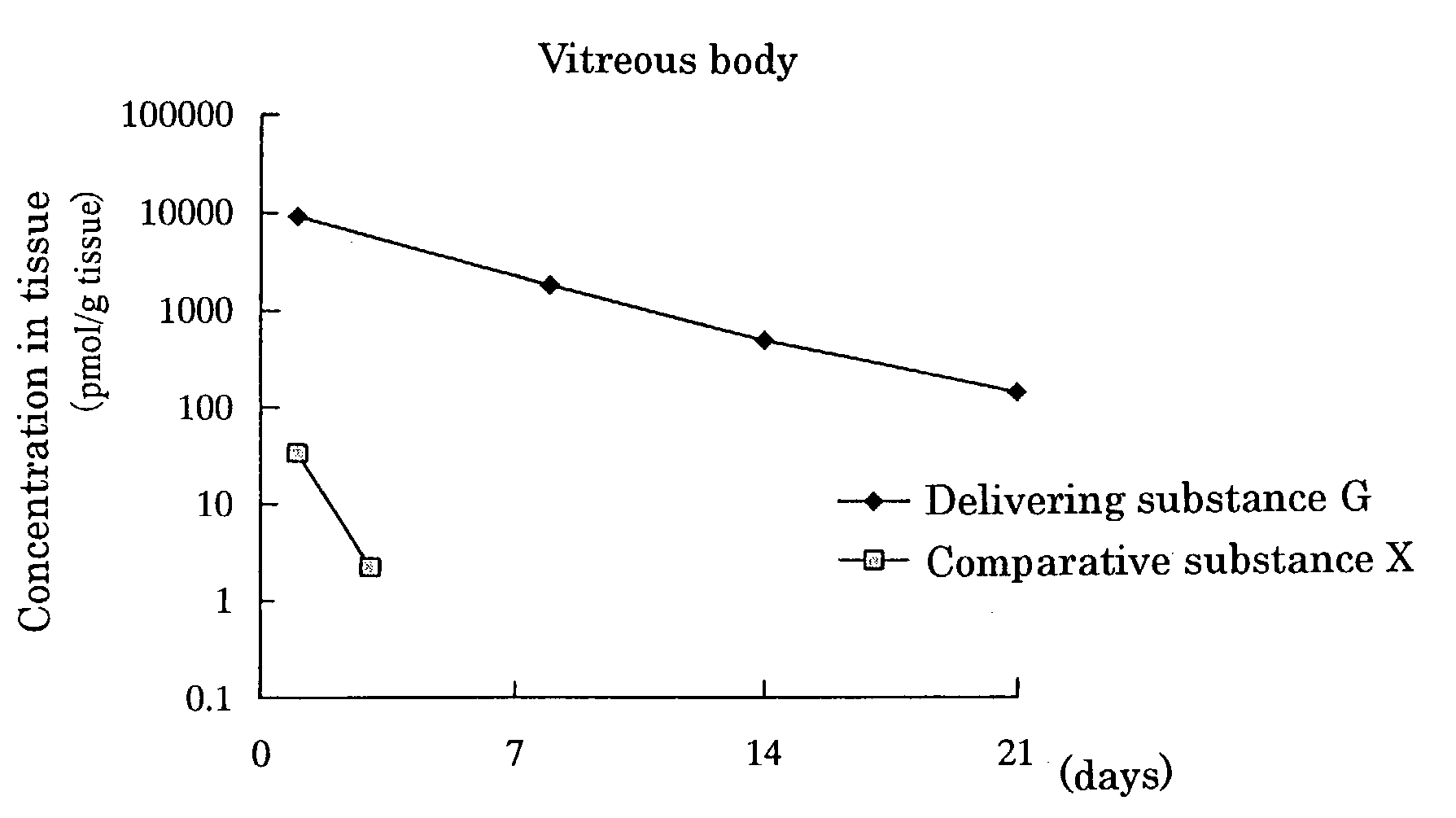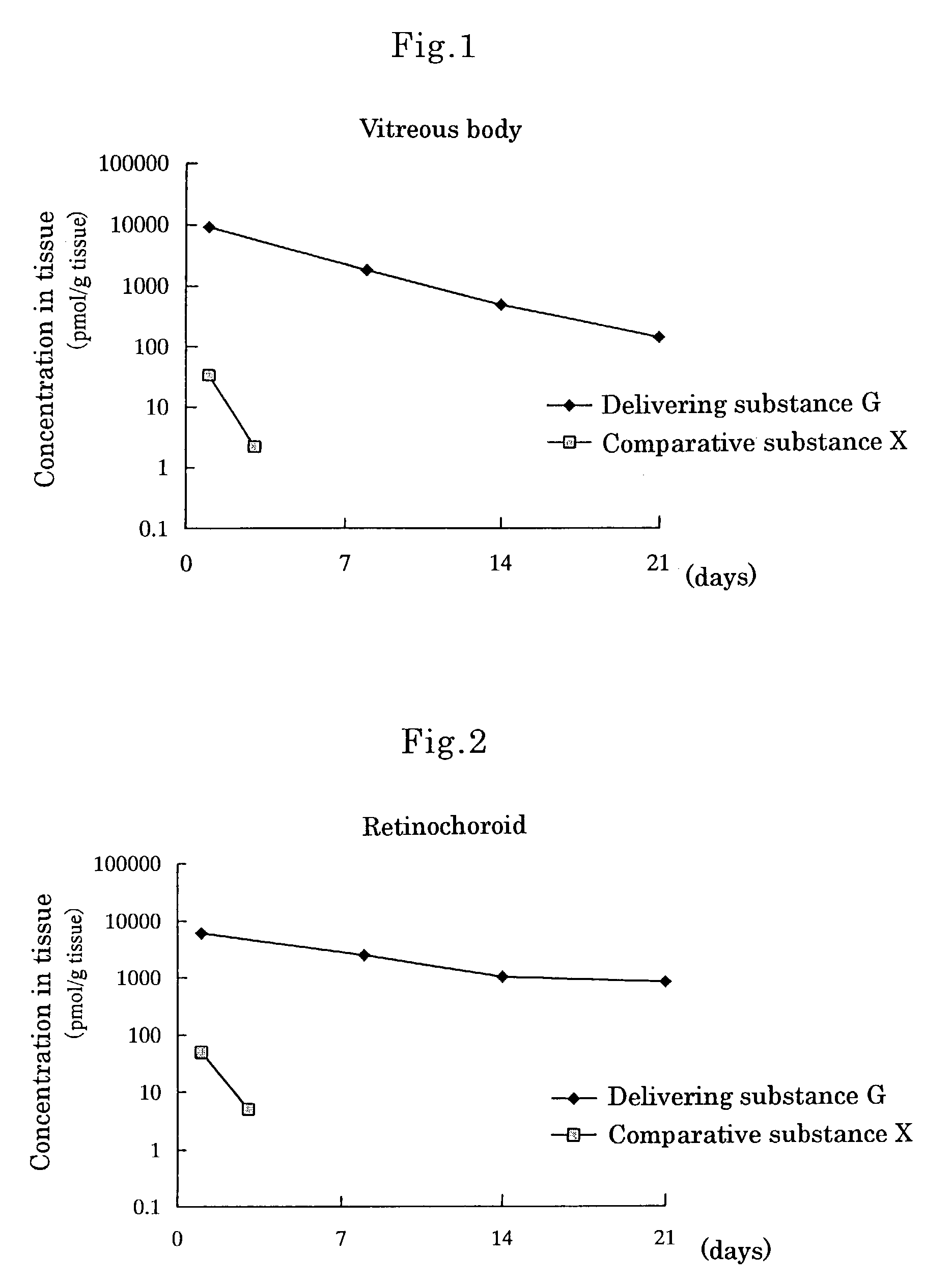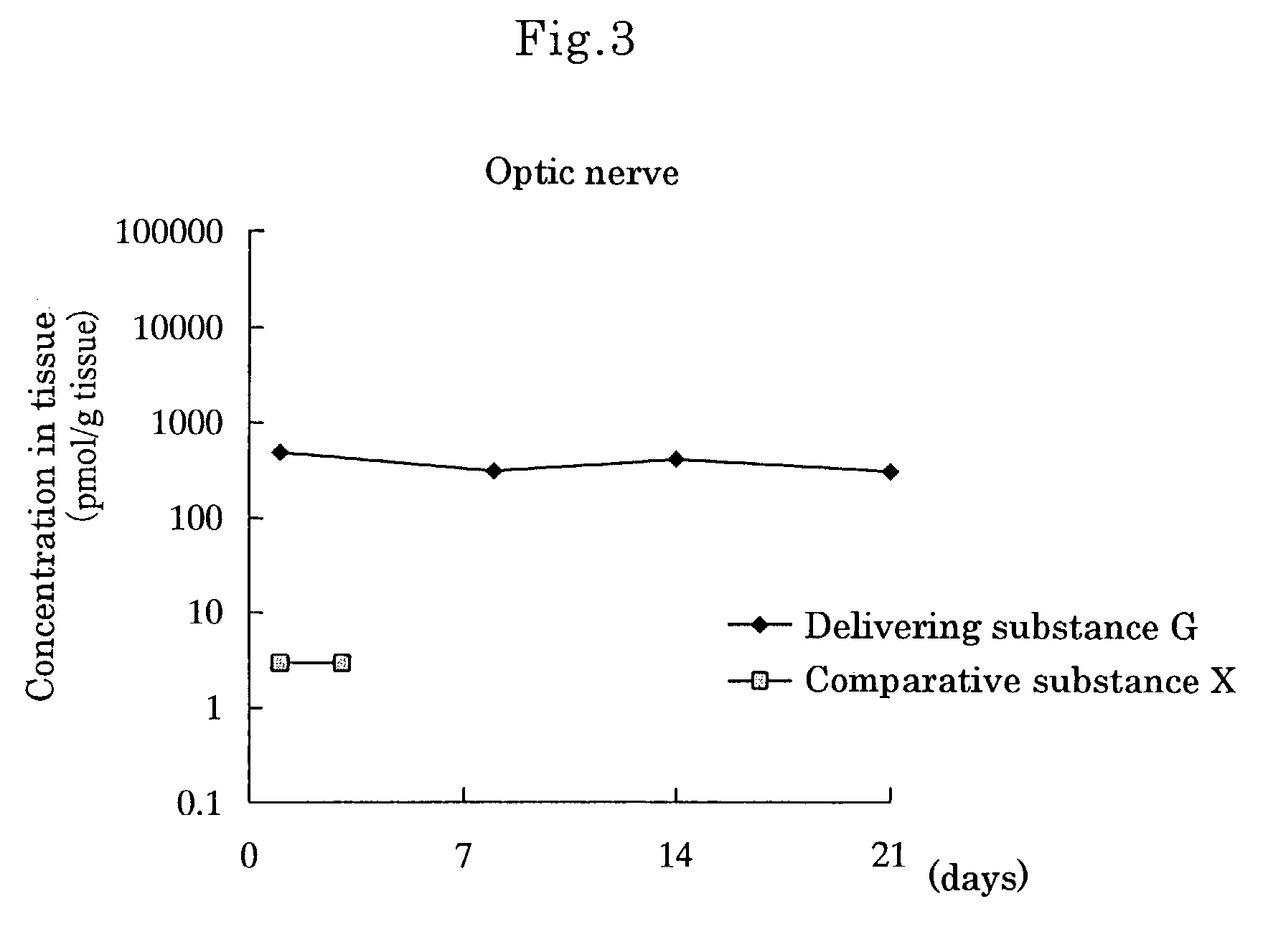Delivering substance and drug delivery system using the same
a technology of drug delivery system and substance, applied in the direction of antibacterial agents, prostheses, immunological disorders, etc., can solve the problems of difficult control of drug release, difficult to deliver the drug to a specific site, and all the difficulty in the treatment of intraocular diseases, so as to reduce the amount of drug linked, reduce side effects, and maintain efficiency
- Summary
- Abstract
- Description
- Claims
- Application Information
AI Technical Summary
Benefits of technology
Problems solved by technology
Method used
Image
Examples
example 1
[0041](1) Delivering substance A, wherein[0042]① a compound wherein hydrogen of one terminal OH group of polyethylene glycol (molecular weight: 5,000) is substituted by thioureidoethyl and hydrogen of the other terminal OH group is substituted by carbonylethyl,[0043]② fluorescein and[0044]③ L-α-distearoylphosphatidylethanolamine are linked by covalent bonds [chemical formula 6]
[0045]Methylene chloride (10 ml), chloroform (5 ml) and triethylamine (25 μl, 0.18 mmol) were added to a mixture of an active ester wherein hydrogen of one terminal OH group of polyethylene glycol (molecular weight: 5,000) was substituted by fluoresceinylthioureidoethyl and hydrogen of the other terminal OH group was substituted by succinimidyloxycarbonylethyl (Fluor-NHS-5k) [produced by Nippon Oils & Fats Co., Ltd.] (0.20 g, ca. 40 μmol) and L-α-distearoylphosphatidylethanolamine (61 mg, 82 μmol), and the whole was stirred at room temperature overnight. Then, p-toluenesulfonic acid (40 mg, 0.21 mmol) was adde...
example 2
Delivering Substance F, wherein
[0073]① a compound wherein hydrogen of both terminal OH groups of polyethylene glycol (molecular weight: 5,000) is substituted by carbonylethyl,[0074]② (±) -3,4-dihydro-2-[5-methoxy-2-[3-[2-(3,4-methylenedioxy)phenoxyethyl-amino]propoxy]phenyl]-4-methyl-3-oxo-2H-1,4-benzothiazine and[0075]③ L-α-distearoylphosphatidylethanolamine are linked by covalent bonds [chemical formula 7]
[0076]Chloroform (5 ml) was added to (±)-3,4-dihydro-2-[5-methoxy-2-[3-[2-(3,4-methylenedioxy)phenoxyethylamino]propoxy]phenyl]-4-methyl-3-oxo-2H-1,4-benzothiazine monooxalate [a process for preparing this compound is disclosed Japanese Laid-open Patent Publication No. 123181 / 1987.] (54 mg, 88 μmol), and the obtained mixture was stirred at room temperature. To the mixture were added triethylamine (0.04 ml, 0.3 mmol) and then an active ester wherein hydrogen of one terminal OH group of polyethylene glycol (molecular weight: 5,000) was substituted by L-α-distearoylphosphatidyloxyet...
example 3
[0080]Delivering Substance G, wherein[0081]① a compound wherein hydrogen of both terminal OH groups of polyethylene glycol (molecular weight: 5,000) is substituted by carbonylethyl,[0082]② [5R, 10S]-(+)-5-methyl-10,11-dihydro-5H-dibenzo[a,d]cycloheptene-5,10-imine and[0083]③ L-α-distearoylphosphatidylethanolamine are linked by covalent bonds [chemical formula 8]
[0084]Methylene chloride (6.4 ml) was added to [5R,10S]-(+)-5-methyl-10,11-dihydro-5H-dibenzo[a,d]cycloheptene-5,10-imine [Dizocilpine] maleate (0.12 g, 0.36 mmol) under a nitrogen atmosphere, and the obtained mixture was stirred at room temperature. To the mixture were added triethylamine (0.18 ml, 1.3 mmol) and then an active ester wherein hydrogen of one terminal OH group of polyethylene glycol (molecular weight: 5,000) was substituted by L-α-distearoylphosphatidyl-oxyethylaminocarbonylethyl and hydrogen of the other terminal OH group was substituted by succinimidyloxycarbonylethyl (DSPE-NHS-5000) [produced by Nippon Oils ...
PUM
| Property | Measurement | Unit |
|---|---|---|
| ri | aaaaa | aaaaa |
| ri | aaaaa | aaaaa |
| ri | aaaaa | aaaaa |
Abstract
Description
Claims
Application Information
 Login to View More
Login to View More - R&D
- Intellectual Property
- Life Sciences
- Materials
- Tech Scout
- Unparalleled Data Quality
- Higher Quality Content
- 60% Fewer Hallucinations
Browse by: Latest US Patents, China's latest patents, Technical Efficacy Thesaurus, Application Domain, Technology Topic, Popular Technical Reports.
© 2025 PatSnap. All rights reserved.Legal|Privacy policy|Modern Slavery Act Transparency Statement|Sitemap|About US| Contact US: help@patsnap.com



